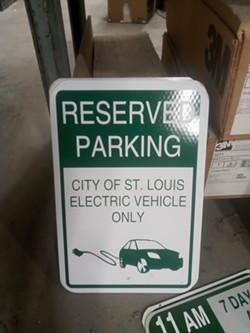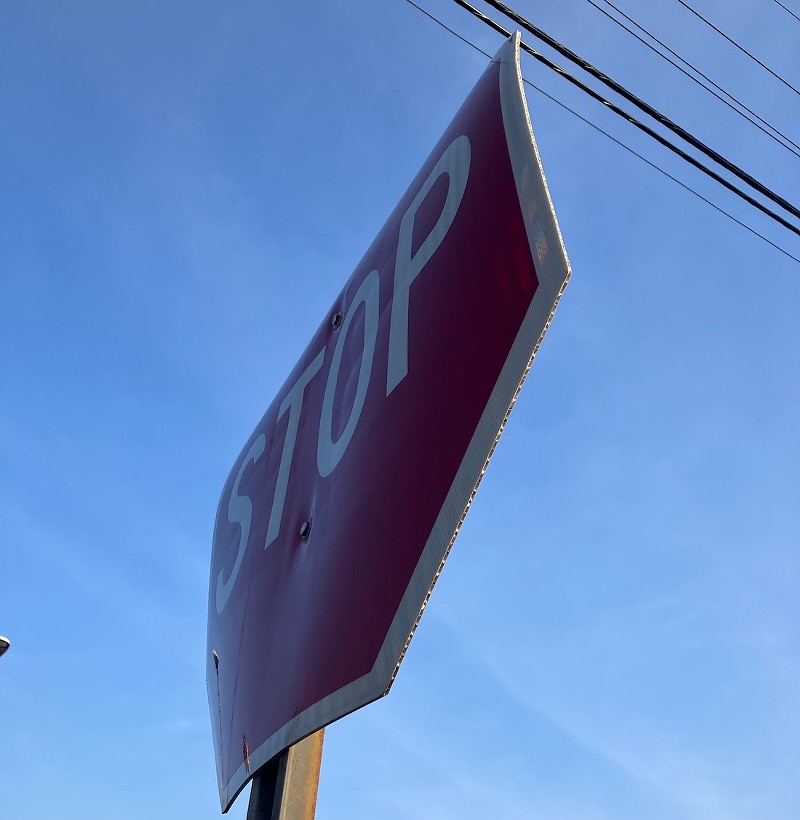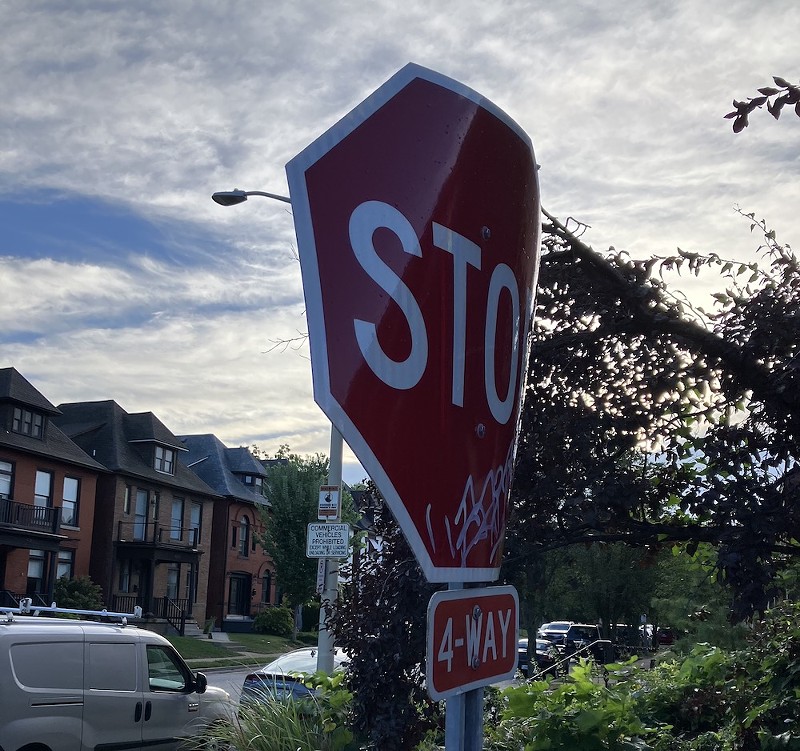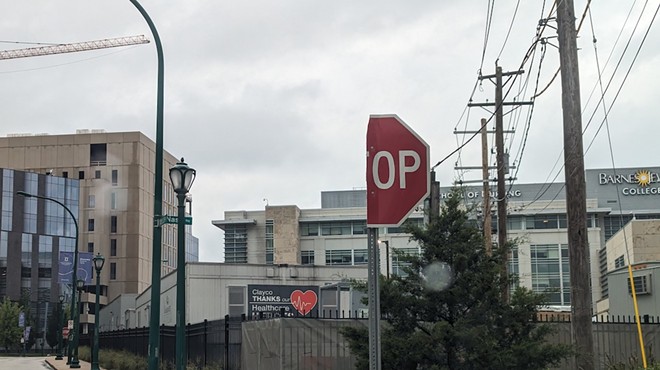But now the city says it never used corrugated cardboard, only a "hardened plastic corrugated material" — and that said switch had nothing to do with the flood. Oh, and it actually switched in the last year to a totally different material — and that was because of the flood.
Got all that? It turns out the flood didn't compel the city to start using easily damaged signs. It actually got them to stop using them.
I started looking into changes to St. Louis street signs in early August after getting reports that some stop signs around the city had seemingly been bisected. Presuming the signs were made of a classic metal, I wondered who'd gone to such lengths. "Does St. Louis have a serial stop sign slasher?" I asked in a headline.
As I would soon learn, however, the city's signs haven't been metal for years. In answer to my inquiry a few weeks ago, the city confirmed as much, saying it had switched to corrugated cardboard after flooding rendered the Street Department's facility in Ellendale inoperable.

DWIGHT JOHNSON JR.
Dwight Johnson shares this photo — time-stamped July 2021 — to show that the city switched to cardboard long before the flood.
At the time, his job involved printing and then pressing vinyl onto what he says was corrugated cardboard. He says it was immediately clear the new material was far inferior. It would bend in the machines they used.
"The vinyl keeps coming off," he remembers telling his supervisors. "It's not going to work."
Confronted with Johnson's account, the city acknowledged that its initial timeline had been incorrect. Jamie Wilson, commissioner of traffic, said in a phone interview on September 1 that the city actually made the switch from fiberglass to a "hardened plastic corrugated material" two or three years ago — at least a year before the flood. Wilson said the city's fiberglass sign supplier had stopped making them, so "the department explored other options."
But, Wilson insisted, the signs are not actually cardboard (again, "hardened plastic corrugated material" was as descriptive as he was willing to get). Despite the various bent and bisected signs that have been spotted around town, he says the city has had no problems with the lighter material.
Instead, he says, they switched to a third option last summer because of, yes, the flood that ravaged Ellendale.
"It destroyed the Street Department where we applied sheeting and lettering," he says. "We weren't able to occupy the building." Needing new signs, they switched to aluminum ones purchased through the Missouri Department of Transportation.
Even so, Wilson believes the city's use of a corrugated material — whether cardboard or a "hardened plastic corrugated material" — was a success. "I've never had a complaint given to me about plastic signs," he says. He also says he received zero allegations of increased sign vandalism.
Johnson, however, tells a different story. He says the change in quality from fiberglass to what he describes as cardboard was noticeable.
"It was the wrong kind of material," he says. "That's why you get people cutting them in half."
Before the switch to corrugated signs, he says, "It worked. It wasn't cheap, but it wasn't expensive either. Cardboard signs are $6 a pop. You get what you pay for." He estimates there are up to 2,000 cardboard versions out there on the city streets, and he's not the least bit surprised that they're bending on their posts (and being bisected).
Johnson acknowledges that he is plenty annoyed at the city. A St. Louis native and military veteran, he had dreams of working for his hometown and took a job back in 2011 as a utility worker hoping to put his degree in graphic design to use. It took years, but he was finally formally promoted in 2020 to become a traffic arts technician.
But his years working for the city were frustrating in the extreme. He ended up filing a grievance over an unsafe work situation, which was substantiated, and ultimately went on leave due to the stress of the job.
On August 30, he officially gave two weeks notice.
"In all, this department needs to be investigated thoroughly, but it's highly unlikely. I do wish that success does come in the future for the city employees that continue to work hard but smart like myself," he wrote in his resignation letter. "I hope the incompetent, and inconsistencies that work in management are replaced with transparent individuals that can turn that department around. What's going on in my city is truly heart breaking and all I can do is wish for the best.
"I also did not want to take the responsibility of creating defected or lazy signage that has been displayed on the City of Saint Louis streets," he continued. "That is also a safety hazard for the communities as a whole."
Wilson declined comment on all personnel issues.
Perhaps the only thing Johnson and Wilson agree upon is the St. Louis Street Department is extremely short-staffed. Wilson says, "In general, we've been operating with one-fourth to one-third of our positions vacant. For the Street Department overall, that's consistent."
Wilson notes that a new change to state law removes the residency requirement for city workers, and he's hopeful more people will now apply.
In the meantime, he asked the RFT for coordinates on one of the bent signs we reported on in August. Through a spokesman, he later reported that the department investigated the sign and that it is indeed plastic, not cardboard.
The spokesman said the city has since replaced it with a metal sign.

SARAH FENSKE
This cardboard sign, spotted in the Shaw neighborhood on August 23, has since been replaced with a metal version.
Subscribe to Riverfront Times newsletters.
Follow us: Apple News | Google News | NewsBreak | Reddit | Instagram | Facebook | Twitter | Or sign up for our RSS Feed










